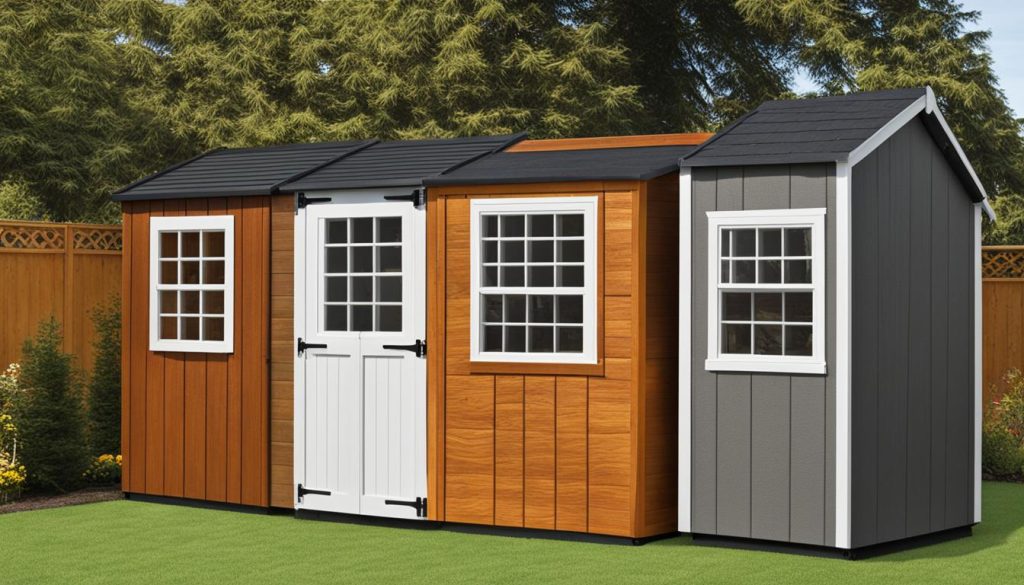
Tongue and Groove vs Overlap Sheds: Which to Choose?
When choosing a shed for your garden, it’s important to consider the cladding and construction. There are different types of sheds, including tongue and groove and overlap sheds, each with their own advantages and disadvantages. In this article, we will explore the differences between these two shed types to help you make an informed decision.
Key Takeaways:
- Tongue and groove sheds and overlap sheds are two popular types of sheds used for outdoor storage in gardens.
- Tongue and groove sheds feature interlocking planks of wood, providing superior weather resistance and durability.
- Overlap sheds have horizontal panels that overlap, offering a lower cost option for storage purposes.
- Consider your specific needs, budget, and desired level of protection when choosing between these shed types.
- The type of treatment, whether dip treatment or pressure treatment, can impact the longevity and maintenance of your shed.
What is Overlap Cladding?
Overlap cladding is a popular and cost-effective construction style for wooden sheds. It involves the use of horizontal panels that overlap each other, forming a simple and straightforward design. This type of cladding is commonly used for storage sheds due to its ease of production and lower cost compared to other construction methods.
One of the key benefits of overlap cladding is its ability to allow rainwater to run off easily. The overlapping panels create a watertight structure, protecting the contents of the shed from moisture and keeping them dry. However, it’s important to note that overlap sheds may be more susceptible to draughts and damp air compared to other types of sheds.
While overlap cladding offers a practical and affordable solution for storage needs, it may not be ideal for sheds that require frequent use or demand a high level of insulation. If you’re looking for a shed that provides better protection against draughts and offers more long-term durability, you may want to consider other construction methods such as tongue and groove cladding.
Key Features of Overlap Cladding
| Construction Style | Simple and cost-effective |
|---|---|
| Weather Resistance | Watertight, but may be susceptible to draughts |
| Intended Use | Ideal for storage purposes |
| Cost | Lower cost compared to other shed types |
In summary, overlap cladding is a straightforward and affordable construction style for wooden sheds. It provides adequate protection against the elements, making it suitable for storage sheds. However, if you require a shed with better insulation and long-term durability, other construction methods such as tongue and groove cladding may be more suitable.
What is Tongue and Groove Cladding?
Tongue and groove cladding is a superior construction method used for larger sheds and other wooden garden buildings. It involves interlocking planks of wood to create a seamless and durable structure. Unlike overlap cladding, tongue and groove cladding leaves no gaps between the boards, providing excellent weather resistance and protection against moisture and draughts.
This construction style is highly recommended for those seeking a shed that can withstand the elements and provide long-lasting durability. Tongue and groove sheds not only offer superior strength but also a more polished and attractive appearance compared to overlap sheds.
Although tongue and groove sheds come at a higher cost due to the quality of the construction, they provide a worthwhile investment for those looking for a shed that will stand the test of time. The added expense is justified by the increased weather resistance and durability, making tongue and groove cladding the superior choice for those seeking a long-term solution for their outdoor storage needs.
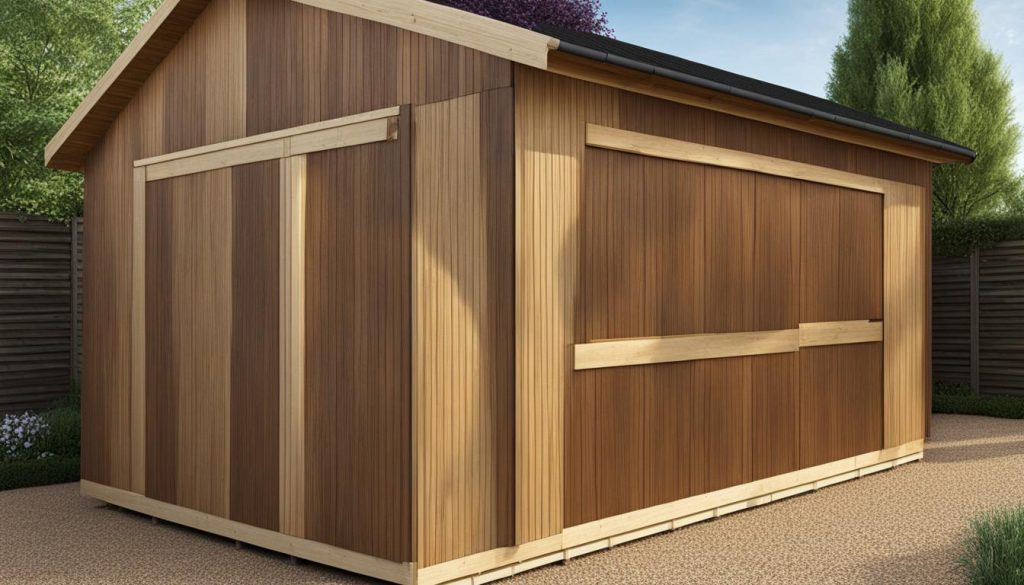
Comparison of Tongue and Groove Cladding and Overlap Cladding
| Tongue and Groove Cladding | Overlap Cladding | |
|---|---|---|
| Construction | Interlocking planks with no gaps | Horizontal panels that overlap |
| Weather Resistance | Excellent | Good |
| Durability | High | Moderate |
| Appearance | Polished and attractive | Simplistic |
| Cost | Higher | Lower |
Pros and Cons of Overlap Sheds
Overlap sheds offer several advantages and disadvantages to consider when choosing a shed for your garden. Let’s explore the pros and cons:
Pros
- Low cost: One of the main benefits of overlap sheds is their affordability. They are generally cheaper to purchase compared to tongue and groove sheds, making them a budget-friendly option for those with limited funds.
- Ideal for storage: Overlap sheds are well-suited for storage purposes. Their simple construction and spacious interiors provide ample room to store garden tools, equipment, and other items.
Cons
- Susceptible to draughts: Due to their overlapping panel design, overlap sheds may be more prone to draughts compared to tongue and groove sheds. This can result in the shed being less insulated and less comfortable to spend extended periods of time in.
- Limited shelving options: If you’re planning to install shelves in your shed, overlap sheds may present some challenges. The overlapping panels make it difficult to attach shelving units securely to the walls, limiting your storage options.
While overlap sheds offer cost-effective storage solutions, it’s important to consider their susceptibility to draughts and limited shelving capabilities. These factors should be taken into account when deciding if an overlap shed is the right choice for your needs.
| Pros | Cons |
|---|---|
| Low cost | Susceptible to draughts |
| Ideal for storage | Limited shelving options |
As illustrated in the table above, the pros of overlap sheds include their affordability and suitability for storage purposes. On the other hand, they have the potential drawback of being more susceptible to draughts and offering limited shelving options.
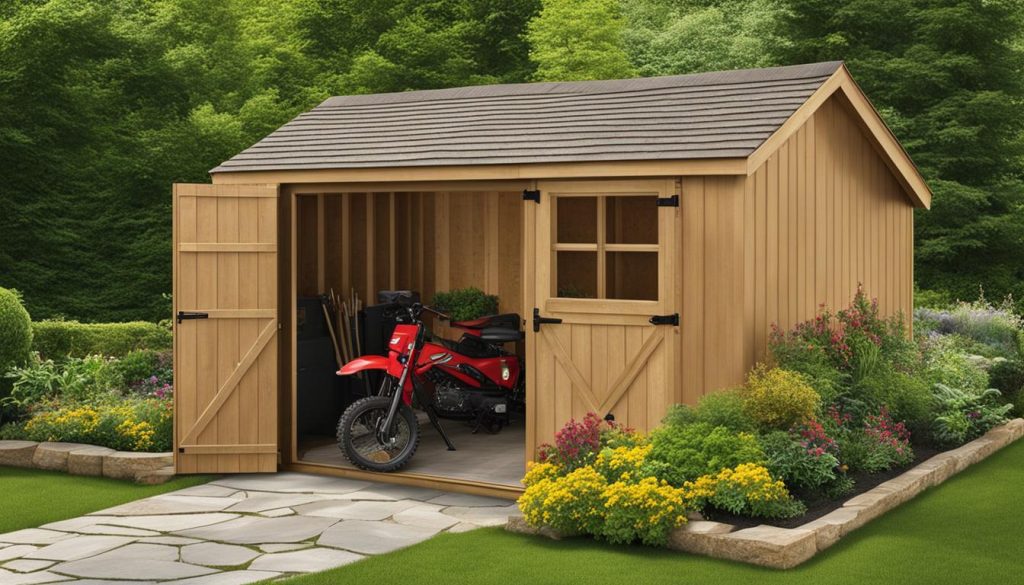
Pros and Cons of Tongue and Groove Sheds
When it comes to choosing a shed for your garden, tongue and groove sheds offer several advantages and disadvantages to consider. Let’s take a closer look at the pros and cons:
Pros of Tongue and Groove Sheds
- Excellent weather resistance: Tongue and groove sheds are known for their superior weather resistance. The interlocking planks create a tight seal, preventing moisture from seeping in and protecting your belongings from rain and humidity.
- Strong construction: The tongue and groove cladding method results in a robust and durable shed structure. The interlocking design adds strength and stability, ensuring that the shed can withstand harsh weather conditions and heavy use over time.
- Protection against moisture and draughts: With no gaps between the boards, tongue and groove sheds provide exceptional protection against moisture and draughts. This makes them a great choice if you plan to use your shed for activities that require a dry and comfortable environment.
Cons of Tongue and Groove Sheds
- Higher cost: One of the main drawbacks of tongue and groove sheds is their higher cost compared to overlap sheds. The superior construction and materials used contribute to the higher price tag, making tongue and groove sheds a bigger investment.
Overall, tongue and groove sheds offer excellent weather resistance, durability, and protection against moisture and draughts. However, their higher cost may be a deterrent for those on a tight budget. Consider your specific needs and budget when deciding which shed type is the best fit for your garden.
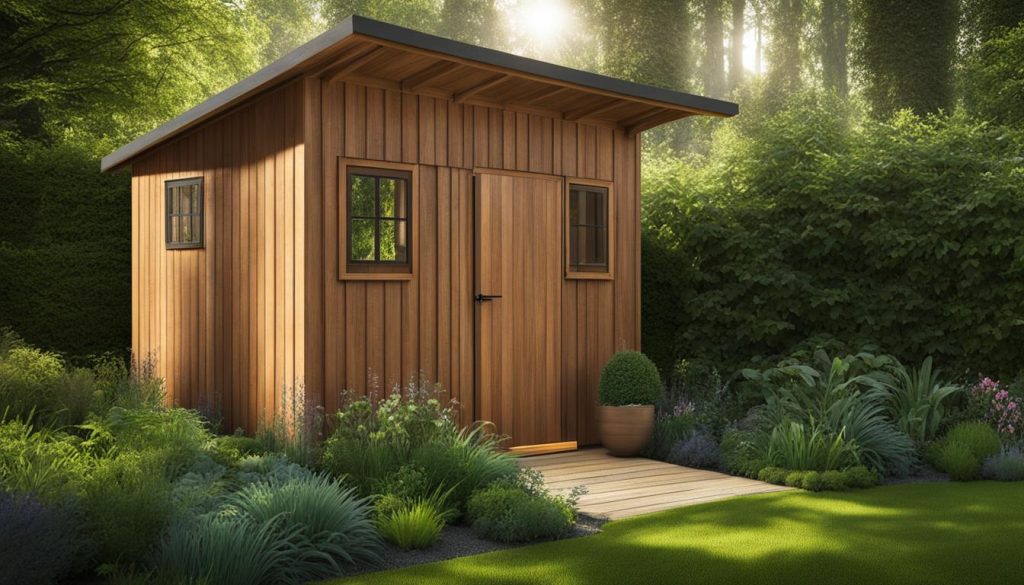
Dip Treatment vs Pressure Treatment
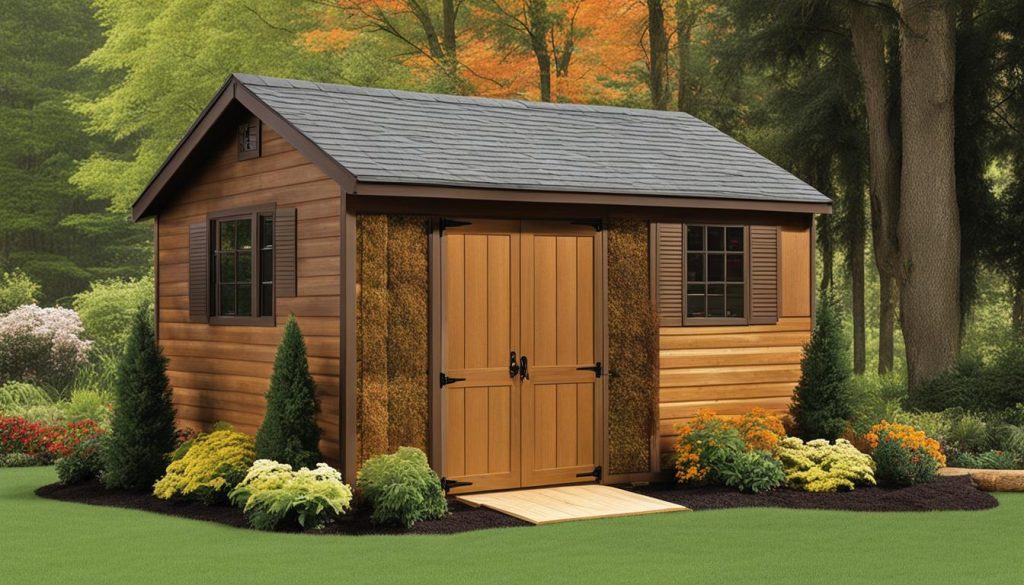
When it comes to preserving the wood of your garden shed, you have two main options: dip treatment and pressure treatment. Both methods aim to protect the wood from rot and decay, but they differ in how they are applied and their long-term effectiveness.
Dip treatment involves immersing the shed panels in a preservative solution. This process coats the exterior of the wood, providing some initial protection against moisture and insects. However, since only the outside is treated, it requires regular reapplication to maintain its effectiveness. This means you’ll need to regularly inspect your shed and apply a fresh coat of preservative as needed.
Pressure treatment, on the other hand, is a more comprehensive method. The wood is placed in a pressure chamber where a preservative solution is forced into the fibers of the wood. This ensures that every inch of the wood is treated, resulting in a more thorough and long-lasting protection against rot and decay. Pressure-treated sheds require less maintenance over time, as the treatment penetrates deep into the wood and remains effective for many years.
Comparing Dip Treatment and Pressure Treatment
To better understand the differences between dip treatment and pressure treatment, let’s summarize their key characteristics in the table below:
| Aspect | Dip Treatment | Pressure Treatment |
|---|---|---|
| Application Method | Immersing shed panels in a preservative solution | Forcing a preservative solution into the wood under pressure |
| Protection | Coats the exterior of the wood | Treats every inch of the wood |
| Maintenance | Requires regular reapplication | Requires less maintenance over time |
| Longevity | Shorter lifespan, needs frequent reapplication | Long-lasting protection, remains effective for many years |
As you can see, pressure treatment offers a more comprehensive and long-lasting solution for preserving the wood of your shed. While pressure-treated sheds may be more expensive initially, they require less maintenance over time, saving you time and effort in the long run. However, if you prefer a lower-cost option and don’t mind regular reapplication, dip treatment can still provide some protection for your shed.
Conclusion
After exploring the differences between tongue and groove sheds and overlap sheds, it is clear that both options have their own advantages and considerations to take into account. When it comes to shed construction, materials, and cladding, it’s important to assess your specific needs and preferences.
If you’re on a budget and looking for a shed primarily for storage purposes, an overlap shed is a cost-effective choice. With its simple construction and low cost, it provides a practical solution for keeping your garden tools and equipment safe and secure. However, it’s worth noting that overlap sheds may be more susceptible to draughts and damp air.
On the other hand, if you prioritize durability and superior weather resistance, a tongue and groove shed is the way to go. With its interlocking planks and tight construction, it offers excellent protection against moisture and draughts. Although tongue and groove sheds come at a higher cost, their durability and attractive appearance make them a worthy investment for those seeking a more long-lasting shed.
Lastly, when considering shed materials, it’s crucial to think about the treatment they have undergone. Dip treatment is a common choice, but it requires regular reapplication and only covers the exterior of the panels. Alternatively, pressure treatment treats every inch of the wood and provides long-lasting protection against rot and decay, reducing the need for frequent maintenance.